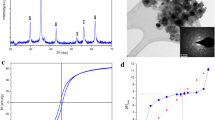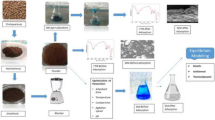Abstract
Hexavalent chromium has been proved to be the reason of several health hazards. This study aimed at evaluating the application of pomegranate seeds powder for chromium adsorption (VI) from aqueous solution. Chromium adsorption percentage (VI) increased with increasing the adsorbent dosage. Chromium adsorption capacity (VI), at pH = 2 and 10 mg/L initial metal concentration, decreased from 3.313 to 1.6 mg/g through increasing dosage of adsorbent from 0.2 to 0.6 g/100 ml. The adsorption rate increased through increase in chromium initial concentration (VI). However, there was a removal percentage reduction of chromium (VI). Chromium adsorption kinetics by different models (pseudo-first-order, modified pseudo-first-order, pseudo-second-order, Elovich, intraparticle diffusion, Boyd kinetic) was investigated as well. Studies on adsorption kinetic indicated that the experimental data were matched by pseudo-second-order model (R 2 = 0.999) better. Obtained results demonstrated the pomegranate seeds can be used as an effective biomaterial and biosorbent for hexavalent chromium adsorption from aqueous solutions.





Similar content being viewed by others
References
Acharya J, Sahu J, Mohanty C, Meikap B (2009) Removal of lead(II) from wastewater by activated carbon developed from Tamarind wood by zinc chloride activation. Chem Eng J 149:249–262
Aliabadi M, Khazaei I, Fakhraee H, Mousavian M (2012) Hexavalent chromium removal from aqueous solutions by using low-cost biological wastes: equilibrium and kinetic studies. Int J Environ Sci Technol 9:319–326
Aravind J, Kanmani P, Sudha G, Balan R (2016) Optimization of chromium(VI) biosorption using gooseberry seeds by response surface methodology. Glob J Environ Sci Manag 2:61–68
Aravindhan R, Fathima A, Selvamurugan M, Raghava Rao J, Balachandran UN (2012) Adsorption, desorption, and kinetic study on Cr(III) removal from aqueous solution using Bacillus subtilis biomass. Clean Technol Environ Policy 14:727–735. doi:10.1007/s10098-011-0440-7
AWWA A (2005) Standard methods for the examination of water and wastewater. Washington, DC
Barkakati P, Begum A, Das ML, Rao PG (2010) Adsorptive separation of Ginsenoside from aqueous solution by polymeric resins: equilibrium, kinetic and thermodynamic studies. Chem Eng J 161:34–45
Boparai HK, Joseph M, O’Carroll DM (2011) Kinetics and thermodynamics of cadmium ion removal by adsorption onto nano zerovalent iron particles. J Hazard Mater 186:458–465
Brungesh K, Nagabhushana B, Raveendra R, Krishna HR, Prashantha P, Nagabhushana H (2015) Adsorption of Cr(VI) from aqueous solution onto a mesoporous carbonaceous material prepared from naturally occurring Pongamia pinnata seeds. J Environ Anal Toxicol 5:1
Dehvari M, Ghaneian MT, Fallah F, Sahraee M, Jamshidi B (2013) Evaluation of maize tassel powder efficiency in removal of reactive red 198 dye from synthetic textile wastewater. J Community Health Res 1:153–165
Di Natale F, Lancia A, Molino A, Musmarra D (2007) Removal of chromium ions form aqueous solutions by adsorption on activated carbon and char. J Hazard Mater 145:381–390
Dubey SP, Gopal K (2007) Adsorption of chromium(VI) on low cost adsorbents derived from agricultural waste material: a comparative study. J Hazard Mater 145:465–470
El-Batouti M, Ahmed A-MM, Zeid FMA, Mohamed N (2015) Removal of chromium and nickel ions from wastewater by rice husk carbon. Asian J Chem 27(10):3721–3728
El Nemr A, El-Sikaily A, Khaled A, Abdelwahab O (2015) Removal of toxic chromium from aqueous solution, wastewater and saline water by marine red alga Pterocladia capillacea and its activated carbon. Arab J Chem 8:105–117
EPA EPA (2015) Method 218.7: determination of Hexavalent chromium in drinking water by ion chromatography with post-column derivatization and UV–visible spectroscopic detection. Office of Water, US
Ghaneian MT, Ehrampoush MH, Arany AM, Jamshidi B, Dehvari M (2013) Equilibrium and kinetic studies of Cr(VI) removal from synthetic wastewater by acroptilon repense flower powder. Pol J Chem Technol 15:40–47
Ghaneian M, Jamshidi B, Dehvari M, Amrollahi M (2015) Pomegranate seed powder as a new biosorbent of reactive red 198 dye from aqueous solutions: adsorption equilibrium and kinetic studies. Res Chem Intermed 41:3223–3234
Heimberg J, Wahl K, Singer I, Erdemir A (2001) Superlow friction behavior of diamond-like carbon coatings: time and speed effects. Appl Phys Lett 78:2449–2451
Jain M, Garg V, Kadirvelu K, Sillanpää M (2016) Adsorption of heavy metals from multi-metal aqueous solution by sunflower plant biomass-based carbons. Int J Environ Sci Technol 13:493–500
Jamshidi B, Ehrampoush MH, Dehvari M (2013) Utilization of olive kernel ash in removal of RB19 from synthetic textile wastewater. J Environ Treat Tech 1:150–156
Kaya K, Pehlivan E, Schmidt C, Bahadir M (2014) Use of modified wheat bran for the removal of chromium(VI) from aqueous solutions. Food Chem 158:112–117
Kumar E et al (2010) Perchlorate removal from aqueous solutions by granular ferric hydroxide (GFH). Chem Eng J 159:84–90
Kumar PS, Ramalingam S, Kirupha SD, Murugesan A, Vidhyadevi T, Sivanesan S (2011) Adsorption behavior of nickel(II) onto cashew nut shell: equilibrium, thermodynamics, kinetics, mechanism and process design. Chem Eng J 167:122–131
Levankumar L, Muthukumaran V, Gobinath M (2009) Batch adsorption and kinetics of chromium(VI) removal from aqueous solutions by Ocimum americanum L. seed pods. J Hazard Mater 161:709–713
Malkoc E, Nuhoglu Y, Dundar M (2006) Adsorption of chromium(VI) on pomace—an olive oil industry waste: batch and column studies. J Hazard Mater 138:142–151
Najim TS, Yassin SA (2009) Removal of Cr(VI) from aqueous solution using modified pomegranate peel: equilibrium and kinetic studies. J Chem 6:S129–S142
Nharingo T, Moyo M, Mahamadi C (2016) Kinetics and equilibrium studies on the biosorption of Cr(VI) by Vigna subterranean (L.) Verdc Hull International. J Environ Res 10:85–96
Ofomaja A, Naidoo E, Modise S (2010) Biosorption of copper(II) and lead(II) onto potassium hydroxide treated pine cone powder. J Environ Manag 91:1674–1685
Oliveira E, Montanher S, Andrade A, Nobrega J, Rollemberg M (2005) Equilibrium studies for the sorption of chromium and nickel from aqueous solutions using raw rice bran. Process Biochem 40:3485–3490
Owlad M, Aroua MK, Daud WMAW (2010) Hexavalent chromium adsorption on impregnated palm shell activated carbon with polyethyleneimine. Bioresour Technol 101:5098–5103
Park D, Lim S-R, Yun Y-S, Park JM (2007) Reliable evidences that the removal mechanism of hexavalent chromium by natural biomaterials is adsorption-coupled reduction. Chemosphere 70:298–305
Park D, Lim S-R, Yun Y-S, Park JM (2008) Development of a new Cr(VI)-biosorbent from agricultural biowaste. Bioresour Technol 99(18):8810–8818
Pehlivan E, Altun T (2008) Biosorption of chromium(VI) ion from aqueous solutions using walnut, hazelnut and almond shell. J Hazard Mater 155:378–384
Rahimi HR, Arastoo M, Ostad SN (2012) A comprehensive review of Punica granatum (pomegranate) properties in toxicological, pharmacological, cellular and molecular biology researches. Iran J Pharm Res 11:385–400
Rudzinski W, Panczyk T (2000) Kinetics of isothermal adsorption on energetically heterogeneous solid surfaces: a new theoretical description based on the statistical rate theory of interfacial transport. J Phys Chem B 104:9149–9162
Sahranavard M, Ahmadpour A, Doosti MR (2011) Biosorption of hexavalent chromium ions from aqueous solutions using almond green hull as a low-cost biosorbent. Eur J Sci Res 58:392–400
Samarghandy MR, Hoseinzadeh E, Taghavi M, Rahmani A (2011) Biosorption of reactive black 5 from aqueous solution using acid-treated biomass of potato peel waste. BioResources 6:4840–4855
Shadborestan A, Khaksar E, Shokrzadeh M, Taghavi M (2013) Cadmium, lead and chromium contents in rice (champa) produced in the mobarakeh county in 2009. J Mazand Univ Med Sci 23:122–127
Taghavi M, Zazouli MA, Yousefi Z, Akbari-adergani B (2015) Kinetic and isotherm modeling of Cd(II) adsorption by l-cysteine functionalized multi-walled carbon nanotubes as adsorbent. Environ Monit Assess 187:1–10
Yousef RI, El-Eswed B, Ala’a H (2011) Adsorption characteristics of natural zeolites as solid adsorbents for phenol removal from aqueous solutions: kinetics, mechanism, and thermodynamics studies. Chem Eng J 171:1143–1149
Yu X, Tong S, Ge M, Zuo J (2013) Removal of fluoride from drinking water by cellulose@ hydroxyapatite nanocomposites. Carbohydr Polym 92:269–275
Zarrabi M, Noori Sepehr M, Amrollahi M, Taghavi M (2015) Biosorption of fluoride by apple pulp from aqueous solution koomesh 16:213–219
Zazouli MA, Yousefi Z, Taghavi M, Akbari-adergani B, Cherati JY (2013) Cadmium removal from aqueous solutions using l-cysteine functionalized single-walled carbon nanotubes. J Mazand Univ Med Sci 23:37–47
Acknowledgements
The authors wish to thank Shahid Sadoughi University of Medical Sciences for supporting this research (Grant Number: 2773).
Author information
Authors and Affiliations
Corresponding author
Additional information
Editorial responsibility: M. Abbaspour.
Electronic supplementary material
Below is the link to the electronic supplementary material.
Rights and permissions
About this article
Cite this article
Ghaneian, M.T., Bhatnagar, A., Ehrampoush, M.H. et al. Biosorption of hexavalent chromium from aqueous solution onto pomegranate seeds: kinetic modeling studies. Int. J. Environ. Sci. Technol. 14, 331–340 (2017). https://doi.org/10.1007/s13762-016-1216-8
Received:
Revised:
Accepted:
Published:
Issue Date:
DOI: https://doi.org/10.1007/s13762-016-1216-8




